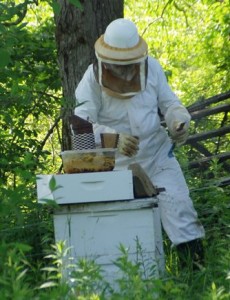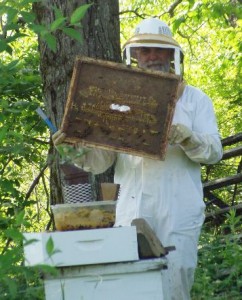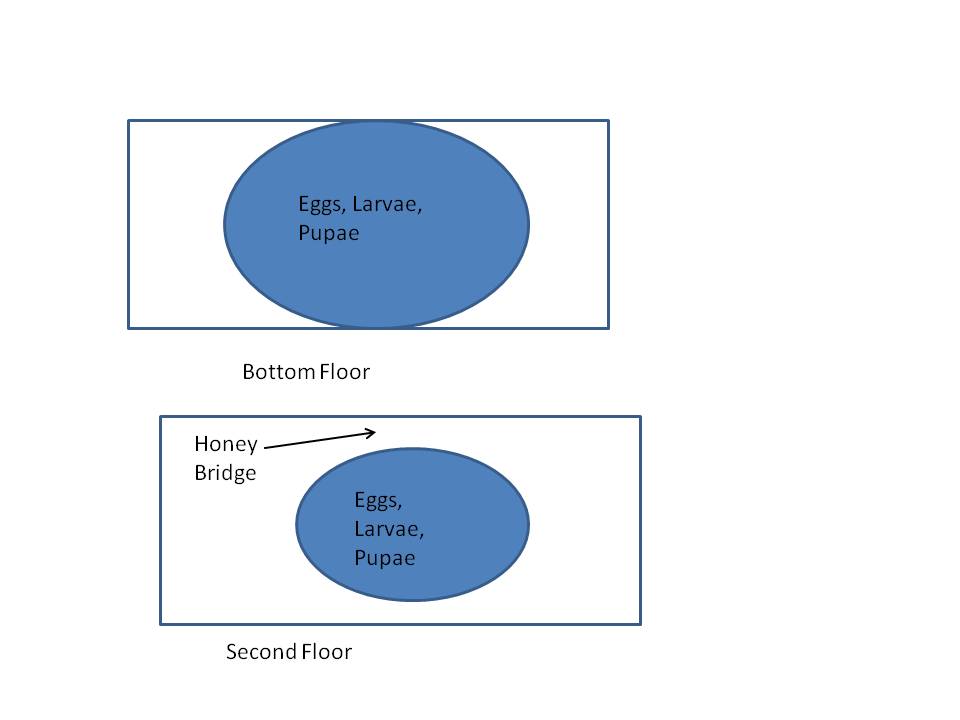 Well, the weather straightened out enough that the DH could go out and check on the bees. Usually, he’d have gone out in the beginning of May but it was cold and rainy and this is not only not good for bees but everyone would have been home, so to speak, so it makes it much more dangerous for the beekeeper in terms of getting stung. On a day like today – bright, sunny, warm, a little breezy, everyone who is supposed to be out and at work… is out and at work. Everyone else is basically busy raising baby bees and doing storage work.
Well, the weather straightened out enough that the DH could go out and check on the bees. Usually, he’d have gone out in the beginning of May but it was cold and rainy and this is not only not good for bees but everyone would have been home, so to speak, so it makes it much more dangerous for the beekeeper in terms of getting stung. On a day like today – bright, sunny, warm, a little breezy, everyone who is supposed to be out and at work… is out and at work. Everyone else is basically busy raising baby bees and doing storage work.
There is a lot of concern about the health of the world’s bees – and it makes a lot of sense since there has been so much damage in terms of disease. I’m not going to get into the whole ‘here are the four major causes of Colony Collapse Disorder’ because this seems to be something that holds a lot of finger pointing at the moment. Your dear Aunty has very strong opinions on this and if you want to know what I think is causing this, let me put it this way: Beekeepers in places such as Chicago, Boston and New York City are not having ‘colony collapse disorder’. I think there is a reason for that and that reason is what is NOT being sprayed around all over the place in large urban centers versus what gets sprayed around in rural areas, especially those places which grow corn and soybeans.
 But, back to the bee report. Last fall, we moved our two bee hives from where we were storing them (due to bear issues) BACK to Chez Siberia. We’d put up a solar electric charger and fencing. The DH examined both hives at that point and knew that one of them just looked a bit weak. He did a bit of feeding going into the winter to try to beef up the hive before it got cold but earlier this spring, he noticed that there were no bees flying from that hive so he knew that the hive was dead. This can happen even without colony collapse disorder. The queen can basically ‘poop out’ (that’s a technical term) and not lay enough eggs to have enough workers to go into the winter. Or, the queen can die, or she’ll ‘abscond’, which means that she takes off with a bunch of workers and some drones due to population pressure or other environmental causes to set up housekeeping elsewhere. Whatever it was, one of the hives was weak in the fall and died over the winter. The other hive was strong in the fall and the DH said it looked great when he opened it up.
But, back to the bee report. Last fall, we moved our two bee hives from where we were storing them (due to bear issues) BACK to Chez Siberia. We’d put up a solar electric charger and fencing. The DH examined both hives at that point and knew that one of them just looked a bit weak. He did a bit of feeding going into the winter to try to beef up the hive before it got cold but earlier this spring, he noticed that there were no bees flying from that hive so he knew that the hive was dead. This can happen even without colony collapse disorder. The queen can basically ‘poop out’ (that’s a technical term) and not lay enough eggs to have enough workers to go into the winter. Or, the queen can die, or she’ll ‘abscond’, which means that she takes off with a bunch of workers and some drones due to population pressure or other environmental causes to set up housekeeping elsewhere. Whatever it was, one of the hives was weak in the fall and died over the winter. The other hive was strong in the fall and the DH said it looked great when he opened it up.
Now if you’ve ever considered keeping bees but felt it was this great mystery, here is the first lesson (besides getting the right equipment, a veil, not wearing yellow, and using your smoker): Using your eyes is the biggest and most effective tool a beekeeper has to evaluating what is going on with a hive and how healthy it is. I asked the DH what he saw (I have to admit that I’ve only suited up and gone out there with him a couple of times and today I was far enough away to take some pictures; I don’t know how the bees would react to my doing that up close with the camera making noise and all that), and here is his report:
“Over all, things are pretty healthy – a lot of worker bees taking off and landing out of the hive. When I took off the cover from the brood box, there was a lot of housekeeping to do: a lot of beeswax and propolis sticking the frames together that I needed to scrape off. On the frames, there was a lot of eggs/pupae/larvae, plus pollen and honey already having been collected. once I’d done the housekeeping, I put on the first honey ‘super’ and closed everything up.”
So, looking at the second photo here, I can identify some items for you:
In the DH’s hand, you see a metal bar-like thing with a blue bottom. That is a ‘hive tool’ (creative name, that). One end is hooked to help separate the tops of the frames if they are stuck together and the other end is sharp to act as a scraper. Also in his hands is the inner cover and you can see this yellowish stuff on it – that is probably beeswax, but it also might be some propolis as well. Propolis is a resinous compound that bees collect from sap from plants and trees and use for various architectural and protective purposes (including antibacterial – bees are amazing). In front of the DH, on top of the dead hive are what looks like a short white drawer and his smoker with the bellows. The short white drawer is the first honey super. The brood box (the bottom two ‘drawers’ of a manmade, managed bee colony) are much taller than the boxes for honey, so the frames that go into the honey super are actually shorter – same width but shorter in height – probably a good 5″ shorter. Which is really a good thing because in a good year, we can get 40 pounds of honey out of a full honey super (and that does not include the weight of the frames themselves or the honey super – that together would be about 25 pounds without the honey, so if we tried to use something the size of a brood box, someone’s back would DEFINITELY be in major trouble.
But, I digress (as usual). When a beekeeper uses his or her eyes to see what is going on, they are looking not only at the cells on the frame, but also the frames in terms of what percentage of the frame is occupied and by what it is occupied. Looking at the diagram, you’ll see I’ve labeled them ‘Bottom Floor’ and “Second Floor”. These are the two ‘drawers’ in the brood box. In the top diagram, you see that the blue oval (occupied by the eggs, pupae and larvae) takes up pretty much most of the frame – probably 80%. The rest of it should be (and when the DH went out today, it was) occupied by honey and pollen. The bottom diagram is the ‘second floor’ and as you can see, the blue oval for eggs, pupae and larvae is actually much smaller and the pollen and honey occupies more space. As a matter of fact, the cells with honey in them go entirely across the top of the frame; this is called ‘the honey bridge’. The DH says that this is a really good sign of hive health and shows that the bees are working hard and bringing home the goods (so to speak). Finally, the DH told me that he’d also found queen cells, which is something that beekeepers keep an eye out for all the time, especially in the springtime. The workers are always going to make queen cells; that is the way they are. The trick is to find them and frankly get rid of them; if you do not, then a second (or even third) queen will emerge, a fight will ensue, and one of the queens will abscond with workers and drones to establish a new hive elsewhere. This is called swarming. So, if you see or find a big ball of bees in a tree or bush in your yard, you will know that someplace close by, a hive (natural or manmade) has broken off a new group, which now is literally hanging around waiting for the scout bees to come back to tell them that they’ve found an old tree cavity, or a hole in a wall of a house, or an old box someplace that would make a great home for them to build a hive in. Catching a swarm was how the DH and I got started keeping bees – and in general, they are pretty calm creatures. They’ve loaded up on honey, so their tummies are full and they can’t bend their tails down to sting, and they are not particularly interested in flying around to get at you since they are waiting for word from the scouts. Frankly what we did was climb up the tree with a big cardboard box, put the box right underneath the ball, cut the branch carefully so that we could place the ball into the box, and sealed it up. Then, we put it into the shade, jumped into the car and ran off to a beekeeper friend for a brood box, etc. to get things started.
Looking at the diagram, you’ll see I’ve labeled them ‘Bottom Floor’ and “Second Floor”. These are the two ‘drawers’ in the brood box. In the top diagram, you see that the blue oval (occupied by the eggs, pupae and larvae) takes up pretty much most of the frame – probably 80%. The rest of it should be (and when the DH went out today, it was) occupied by honey and pollen. The bottom diagram is the ‘second floor’ and as you can see, the blue oval for eggs, pupae and larvae is actually much smaller and the pollen and honey occupies more space. As a matter of fact, the cells with honey in them go entirely across the top of the frame; this is called ‘the honey bridge’. The DH says that this is a really good sign of hive health and shows that the bees are working hard and bringing home the goods (so to speak). Finally, the DH told me that he’d also found queen cells, which is something that beekeepers keep an eye out for all the time, especially in the springtime. The workers are always going to make queen cells; that is the way they are. The trick is to find them and frankly get rid of them; if you do not, then a second (or even third) queen will emerge, a fight will ensue, and one of the queens will abscond with workers and drones to establish a new hive elsewhere. This is called swarming. So, if you see or find a big ball of bees in a tree or bush in your yard, you will know that someplace close by, a hive (natural or manmade) has broken off a new group, which now is literally hanging around waiting for the scout bees to come back to tell them that they’ve found an old tree cavity, or a hole in a wall of a house, or an old box someplace that would make a great home for them to build a hive in. Catching a swarm was how the DH and I got started keeping bees – and in general, they are pretty calm creatures. They’ve loaded up on honey, so their tummies are full and they can’t bend their tails down to sting, and they are not particularly interested in flying around to get at you since they are waiting for word from the scouts. Frankly what we did was climb up the tree with a big cardboard box, put the box right underneath the ball, cut the branch carefully so that we could place the ball into the box, and sealed it up. Then, we put it into the shade, jumped into the car and ran off to a beekeeper friend for a brood box, etc. to get things started.
Very exciting, I can tell you.
